Nash Motors
Nash Motors Company was an American automobile manufacturer based in Kenosha, Wisconsin, in the United States from 1916 to 1937. From 1937 to 1954, Nash Motors was the automotive division of the Nash-Kelvinator Corporation. Nash production continued from 1954 to 1957 after the creation of American Motors Corporation.
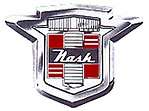 | |
| Industry | Automobile |
|---|---|
| Fate | Merged |
| Successor | Nash-Kelvinator |
| Founded | April 11, 1916 |
| Founder | Charles Williams Nash |
| Defunct | February 23, 1954 |
| Headquarters | Kenosha, Wisconsin, United States |
Key people | Charles W. Nash, Nils Erik Wahlberg |
| Products | Vehicles |
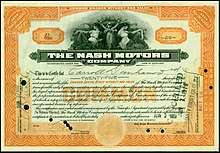
Nash pioneered some important innovations; in 1938 they debuted the heating and ventilation system which is still used today, unibody construction in 1941, seat belts in 1950, a US built compact car in 1950, and muscle cars in 1957.[1]
History
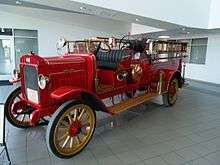

Nash Motors was founded in 1916 by former General Motors president Charles W. Nash who acquired the Thomas B. Jeffery Company. Jeffery's best-known automobile was the Rambler whose mass production from a plant in Kenosha, Wisconsin began in 1902.
The 1917 Nash Model 671 was the first vehicle produced to bear the name of the new company's founder.[2] Sales were positive for 1918 at 10,283 units. More models were added in 1919 and sales rose to 27,081 for the year.
Nash enjoyed decades of success by focusing its efforts to build cars "embodying honest worth ... [at] a price level which held out possibilities of a very wide market."[3]
The four-wheel drive Jeffery Quad truck became an important product for Nash. Approximately 11,500 Quads were built between 1913 and 1919. They served to move material during World War I under severe conditions. The Quad used Meuhl differentials[4] with half-shafts mounted above the load-bearing dead axles to drive the hubs through hub-reduction gearing.[5] In addition, it featured four-wheel steering.[6] The Quad achieved the reputation of being the best four-wheel drive truck produced in the country.[7] The newly formed Nash Motors became the largest producer of four-wheel drives.[8] By 1918, capacity constraints at Nash meant the Paige-Detroit Motor Car Company began to assemble the Nash Quad under license and Nash patents.[9] Nash became the leading producer of military trucks by the end of World War I.[10] After the war ended, surplus Quads were used as heavy work trucks in fields such as construction and logging.[11]
Charles Nash convinced the chief engineer of GM's Oakland Division, Finnish-born Nils Eric Wahlberg, to move to Nash's new company.[12] The first Nash engine introduced in 1917 by Wahlberg had overhead valves.,[13] which Nash had learned about while working for Buick. Wahlberg is also credited with helping to design flow-through ventilation that is used today in nearly every motor vehicle. Introduced in 1938, Nash's Weather Eye directed fresh, outside air into the car's fan-boosted, filtered ventilation system, where it was warmed (or cooled), and then removed through rearward placed vents.[14] The process also helped to reduce humidity and equalize the slight pressure differential between the outside and inside of a moving vehicle. Another unique feature of Nash cars was the unequal wheel tracks. The front wheels were set slightly narrower than the rear, thus adding stability and improving cornering. Wahlberg was also an early proponent of wind tunnel testing for vehicles and during World War II worked with Theodore (Ted) Ulrich in the development of Nash's radically styled Airflyte models.[15]
Nash's slogan from the late 1920s and 1930s was "Give the customer more than he has paid for" and the cars lived up to it. Innovations included a straight-eight engine with overhead valves, twin spark plugs, and nine crankshaft bearings in 1930. The 1932 Ambassador Eight had synchromesh transmissions and free wheeling, automatic centralized chassis lubrication, a worm-drive rear end, and its suspension was adjustable inside the car. A long-time proponent of automotive safety, Nash was among the early mid- and low-priced cars to offer four-wheel brakes.
The Nash was a success among consumers that meant for the company "selling for a long time has been 100% a production problem... month after month all the cars that could be produced were sold before they left the factory floor."[3]
Creation of the Ajax
For the 1925 model year, Nash introduced the entry-level marque Ajax. The Ajax was produced in the newly acquired Mitchell Motor Car Company plant in Racine, Wisconsin. Mitchell was the manufacturer of Mitchell-brand automobiles between 1903 and 1923. Sales of Ajax automobiles, while quite respectable, were disappointing. It was believed that the same car would sell better if it were called a Nash. Thus the Ajax became the "Nash Light Six" in June, 1926 and sales did improve, just as expected. In an unusual move, Nash Motors offered all Ajax owners a kit to "convert" their Ajax into a Nash Light Six. This kit, supplied at no charge, included a set of new hubcaps, radiator badge, and all other parts necessary to change the identity of an Ajax into that of a Nash Light Six. This was done to protect Ajax owners from the inevitable drop in resale value when the Ajax marque was discontinued. In this way Nash Motors showed the high value they placed upon their customers' satisfaction and well-being. Most Ajax owners took advantage of this move, and "unconverted" Ajax cars are quite rare today.
Acquisition of LaFayette
LaFayette Motors was the producer of a large, powerful, expensive luxury car. The company started in Indianapolis, Indiana, in 1920, and later moved to Milwaukee, Wisconsin. The principal stockholder in LaFayette Motors was Nash Motors Company. Other major stockholders were Charles W. Nash and friends and business associates. The high quality, high priced LaFayette cars did not sell well.
In 1924, Nash absorbed LaFayette Motors and converted its plant to produce Ajax automobiles. The LaFayette name was reintroduced in 1934 as a lower priced companion to Nash. LaFayette ceased to be an independent marque with the introduction of the 1937 models. From 1937 through 1940, the Nash LaFayette was the lowest priced Nash, and was replaced by the new unibody Nash 600 for the 1941 model year.
Era of George Mason and Nash Kelvinator
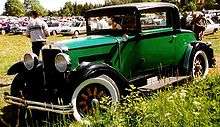
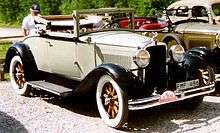
Before retiring, Charles Nash chose Kelvinator Corporation head George W. Mason to succeed him. Mason accepted, but placed one condition on the job: Nash would acquire controlling interest in Kelvinator, which at the time was the leading manufacturer of high-end refrigerators and kitchen appliances in the United States. The resulting company, as of January 4, 1937, was known as the Nash-Kelvinator Corporation. Nash as a brand name continued to represent automobiles for Nash-Kelvinator. This was the largest merger of companies not in the same industry up until that time.
In 1938, Nash introduced an optional conditioned air heating/ventilating system, an outcome of the expertise shared between Kelvinator and Nash. This was the first hot-water car heater to draw fresh air from outside the car, and is the basis of all modern car heaters in use today. Also in 1938, Nash, along with other car manufacturers Studebaker and Graham, offered vacuum-controlled shifting, an early approach at removing the gearshift from the front floorboards. Automobiles equipped with the Automatic Vacuum Shift (supplied by the Evans Products Company) had a small gear selector lever mounted on the dashboard, immediately below the radio controls.
In 1936, Nash introduced the "Bed-In-A-Car" feature, which allowed the car's interior to be converted into a sleeping compartment. The rear seat back hinged up, allowing the rear seat cushion to be propped up into a level position. This also created an opening between the passenger compartment and the trunk. Two adults could sleep in the car, with their legs and feet in the trunk, and their heads and shoulders on the rear seat cushions. In 1949 this arrangement was modified so that fully reclining front seat backs created a sleeping area entirely within the passenger compartment. In 1950 these reclining seat backs were given the ability to lock into several intermediate positions. Nash soon called these new seat backs "Airliner Reclining Seats".
In 1939, Nash added a thermostat to its "Conditioned Air System", and thus the famous Nash Weather Eye heater was born. The 1939 and 1940 Nash streamlined cars were designed by George Walker and Associates and freelance body stylist Don Mortrude. They were available in three series - LaFayette, Ambassador Six and Ambassador Eight. For the 1940 model cars Nash introduced independent coil spring front suspension and sealed beam headlights.
The 1941, Nash 600 was the first mass-produced unibody construction automobile made in the United States. Its lighter weight compared to body-on-frame automobiles and lower air drag helped it to achieve excellent fuel economy for its day. The "600" model designation is said to have been derived from overdrive-equipped examples of this car's ability to travel 600 miles (966 km) on a 20-US-gallon (75.7 l; 16.7 imp gal) tank of gasoline. In other words, it would achieve 30 miles per US gallon (7.8 L/100 km; 36 mpg‑imp). The 600 models used an unusual steering/front suspension system with extremely long king pins. Inadequate lubrication became a problem for these systems, commonly resulting in premature failures. The design of the cars was improved by new front ends, upholstery, and chrome trim from 1942 to 1948. The larger Ambassador models shared the same bodies with the 600 but placed this unibody structure on top of a conventional frame, resulting in an extremely strong car.
Post-World War II passenger car production resumed on October 27, 1945 with an Ambassador sedan first off the assembly line. There were few changes from 1942 models, most noticeable were longer and slimmer upper grille bars and a projecting center section on the lower grille. The 600 models got a new, more conventional front suspension & steering system. Postwar Nashes were six cylinder only; eight cylinder engines did not return. The large Ambassador engine thus was the seven main bearing, overhead-valve, 234-cubic-inch (3.83 L), six-cylinder developing 112 brake horsepower. For the 1946 model year, Nash introduced the Suburban model that used wood framing and panels on the body. It was similar to the Chrysler Town and Country and Ford Sportsman models. Suburbans were continued in 1947 and 1948 models with 1000 built over all three years. In 1948, the Ambassador convertible returned with 1000 built.
Introduction of the Nash Airflyte

The aerodynamic 1949 Nash "Airflyte" was the first car of an advanced design introduced by the company after the war. Its aerodynamic body shape was developed in a wind tunnel. Nils Wahlberg's theories on reducing an automobile body's drag coefficient resulted in a smooth shape and enclosed front fenders. The "cutting-edge aerodynamics" of the all-new postwar design were the most "alarming" in the industry since the Chrysler Airflow.[16] It was built at one of two new factories in El Segundo, California, where the factory is still being used, having been re-purposed as the Boeing Satellite Development Center, immediately south of Los Angeles International Airport, on Nash Street.
A one-piece curved safety glass windshield was used on both models. Wide and low, the automobile featured more interior room than its 1948 predecessor although its height was 6 inches less. Due to its enclosed front fenders Nash automobiles had a larger turning radius than most other cars. The 600 models used a 112-inch (2,800 mm) wheelbase while the Ambassador models stretched to 121 inches (3,073 mm). Both shared the same bodies. Coil springs were used on all four wheels. Three trim lines were offered in both models; Super, Super Special, and the top line Custom. Power was provided by an 82-horsepower (61 kW), 176-cubic-inch (2.88 L) flathead inline 6 cylinder in the 600 and a 112 HP OHV, 234-cubic-inch (3.83 L) inline 6 in the Ambassador.
The few changes for the 1950 Airflytes were a wider rear window, concealed fuel filler cap, some dashboard features and addition on Ambassadors of a GM Hydramatic automatic transmission option. The 600 models were renamed as the "Statesman". A new first for an American car were seat belts, also new was a five-position Airliner reclining front passenger seat back, both optional in both models. The stroke on the Statesman engine was increased 1/4 inch, giving 186 cubic inches (3.05 L) and 85 hp (63 kW), and the Ambassador received a new cylinder head that increased hp to 115.
Changes for the 1951 model Airflytes were to the rear fenders, elongated to incorporate vertical taillights, a new conventional dashboard replacing the Uniscope mounted on the steering column, a new vertical bar grille with horizontal parking lights and addition of GM Hydramatic as a Statesman option also. The three best sales years for Nash up to that time were 1949, 1950 and 1951.
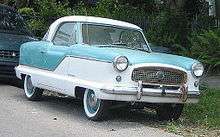
Nash-Kelvinator's President George Mason felt Nash had the best chance of reaching a larger market in building small cars. He directed Nash towards the development of the first compact of the post war era, the 1950 Nash Rambler, which was marketed as an up-market, feature-laden convertible. Mason orchestrated a contract manufacturing arrangement with Austin of the UK to build Nash's new sub-compact car, the Metropolitan, it was introduced as a 1954 model.
The full-size Nash Airflytes were completely re-designed for 1952, and were promoted as the Golden Airflytes, in honor of Nash Motors' 50th anniversary as an automobile builder (the company now counting the years of the Thomas B. Jeffery Company as part of their own heritage.) "Great Cars Since 1902" became one of the company's advertising slogans. Nash was the only American car manufacturer to introduce an all-new 1952 model other than Ford Motor Company. The new Golden Airflytes presented a more modern, squared-off look than did the 1949–51 models, which were often compared to upside-down bathtubs. Pininfarina of Italy was contracted by Nash to design a body for the new Golden Airflyte; however management was unhappy with the design and the result was a combination of an in-house design and Pininfarina's model. Also in 1952, Nash finally began offering automatic transmissions, either a GM Hydramatic or a Borg-Warner overdrive transmission. However, power was still only provided by a six cylinder engine, now bored out to 252 CID.
Using its Kelvinator refrigeration experience, the automobile industry's first single-unit heating and air conditioning system was introduced by Nash in 1954.[20] This was a compact, affordable system for the mass market with controls on the dash and an electric clutch.[21] Entirely incorporated within the engine bay, the combined heating and cooling system had cold air for passengers enter through dash-mounted vents.[20] Competing systems used a separate heating system and an engine-mounted compressor with an Evaporator in the car's trunk to deliver cold air through the rear package shelf and overhead vents. The alternative layout pioneered by Nash "became established practice and continues to form the basis of the modern and more sophisticated automatic climate control systems."[22]
Introduction of the Nash-Healey
1951 saw the introduction of the Anglo-American Nash-Healey sports car, a collaborative effort between George Mason and British sports car manufacturer Donald Healey. Healey designed and built the chassis and suspension and also, until 1952, the aluminum body which another British manufacturer, Panelcraft Sheet Metal Co. Ltd., fabricated in Birmingham West Midlands. Nash shipped the powertrain components to England and Healey assembled the cars, which were then shipped to the U.S. for sale. In 1952 the Italian designer Battista Farina restyled the body, and its construction changed to steel and aluminum. High costs, low sales and Nash's focus on the Rambler line led to the termination of Nash-Healey production in 1954 after 506 automobiles had been produced.
The Nash-Healey, while a welcome attempt to improve Nash's stodgy image, did little to improve showroom traffic as Nash sales fell steadily from 1951 onward. The Airflyte had initially sold well in the postwar "seller's" market, but its bulbous styling, rooted in 1940s design trends, quickly became passe and its underpowered six cylinder engine proved a major liability against GM's new OHV short stroke V8s. Like fellow independents Hudson, Studebaker, and Packard, Nash charged higher prices for their cars than Ford and GM, who benefitted from volume of scale, and lacked the large dealer network or advertising budget of the Big Three. Low profit Rambler sales gradually made up more and more of Nash's total volume. In 1953-54, Ford and GM also waged an all-out price war on each other which further damaged the independents' sales. Mainline Nashes also lacked body styles; despite the introduction of a hardtop coupe in 1952, there was no convertible or station wagon although Rambler featured all of these.
In addition, while Nash had profited from military contracts during the Korean War, that conflict ended in mid-1953. At the same time, new Secretary of Defense Charles E. Wilson, ex-GM president, began steering defense contracts to his former employer at the expense of the rest of the automotive industry.
Mason commissioned Farina to design a Rambler-based two-seater coupe called the Palm Beach, which may have been intended as a successor to the Nash-Healey. However the project did not progress beyond a concept car.[23]
For European endurance racing Healey and his staff designed and built three special Nash-Healeys with lightweight aluminum racing bodies. These competition versions entered four consecutive Le Mans races and one Mille Miglia. At Le Mans they achieved fourth overall in 1950, sixth overall and fourth in class in 1951, third overall and first in class in 1952, and eleventh overall in 1953. In the Mille Miglia they finished ninth overall in 1950 and seventh overall, fourth in class, in 1952.
Creation of American Motors
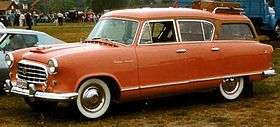
In January 1954, Nash announced the acquisition of the Hudson Motor Car Company as a friendly merger, creating American Motors Corporation (AMC). To improve the financial performance of the combined companies, all production beginning with the 1955 Nash and Hudson models would happen at Nash's Kenosha plant. Nash would focus most of its marketing resources on its smaller Rambler models, and Hudson would focus its marketing efforts on its full-sized cars.
One of the first things Mason did as CEO of the new company was to initiate talks with James J. Nance, president of Packard, for parts-sharing arrangements between AMC and Packard. At this time AMC did not have its own V8 engine and an agreement was made for the new 320 cu in (5.2 L) Packard V8 engine and Packard's Ultramatic automatic transmission to be used in the 1955 Nash Ambassador and Hudson Hornet models.
In July 1954, Packard acquired Studebaker to form Studebaker-Packard Corporation,[24] however further talks of a merger between AMC and Packard-Studebaker were cut short when Mason died on October 8, 1954. A week after his death, Mason's successor, George W. Romney, announced "there are no mergers under way either directly or indirectly".[25] Nevertheless, Romney continued with Mason's commitment to buy components from Studebaker-Packard Corporation. Although Mason and Nance had previously agreed that Studebaker-Packard would purchase parts from AMC, it did not do so. Moreover, Packard's engines and transmissions were comparatively expensive, so AMC began development of its own V8 engine, and replaced the outsourced unit by mid-1956.[26]
For 1955, all the large Nash and Hudson automobiles were based on a Nash-derived, shared common unitized body shell using styling themes by Pinin Farina, Edmund E. Anderson, and Frank Spring. Each had individual powertrains and separate, non-interchangeable body parts.[27] This mimicked the longtime practice Big Three (General Motors, Ford, and Chrysler) that allowed for maximum manufacturing economy. Anderson set up separate design studios for Nash, Hudson, and Rambler.
Also for 1955, George Romney quickly moved to get rid of the unpopular front fender skirts on Nashes and Ramblers, which were widely disliked by customers due to the difficulty they created when steering the cars and changing tires, and reportedly retained due to the insistence of George Mason, who liked the appearance of them.
Even with the merger forming AMC, they were held to a total of about four percent of the market and thus were under pressure to lower expenses and tooling costs for new models, perhaps by innovation.[28]
The Nash Metropolitan, which had been marketed under either the Nash or Hudson brands, became a make unto its own in 1957, as did the Rambler. By this point, Rambler sales made up the vast majority of AMC's volume, so George Romney decided to phase out the Nash and Hudson nameplates and focus solely on Rambler. This move would pay off the following year when an economic recession struck the United States and created a strong demand for economical compact cars.[29] Nash and Hudson production ended with the last Hornet made on June 25, 1957.[30] From 1958 to 1962, Rambler and the Metropolitan were the only brands of cars sold by AMC. By 1965 the Rambler name would begin to be phased out and AMC would take over as the brand name until the 1988 model year. In 1970, American Motors acquired Kaiser Jeep (the descendant of Willys-Overland Motors) and its Toledo, Ohio, based manufacturing facilities. In 1979, AMC entered into a technology partnership with Renault. In 1987, Chrysler Corporation made a public offering to acquire all shares of AMC on the NYSE. The shareholders approved the offer and AMC became a division of Chrysler Corporation.
International markets
Since the early days, Nash vehicles were exported as complete cars or in knock-down kit form for local assembly to many countries around the world including right-hand-drive markets such as United Kingdom[31], Australia, New Zealand, and South Africa. International production for both the Nash and Hudson marques was consolidated after the merger of Nash and Hudson to form American Motors Corporation (AMC) in 1954 after which operations thereafter occurring at the former Nash plant in Kenosha and at the Brampton plant in Canada until 1957 when both the Nash and Hudson marques were retired.
Australia
A number of distributors for each of the Australian states built and sold Nash vehicles beginning in the 1920s. As was the practice for all car brands during the early 20th Century, the chassis and engines were imported and the bodies were locally built by Australian coach builders. Early distributors were Wilsford Limited for New South Wales,[32] Richards Brothers for Victoria and the Riverina,[33] Peels Limited for Queensland,[34] Eric Madren Motors (later Nash Cars (W.A) Limited) for Western Australia,[35] and Northern Motors for Tasmania.[36] The recovery period following the end of World War II saw a lull in car manufacturing, petrol rationing, and currency shortages. Despite these factors, some cars were imported in the late 1940s. After the Nash-Hudson merger in 1954, AMC's new Rambler vehicles were assembled by Ira L. & A.C Berk Pty Ltd[37] which had previously held the Hudson franchise since 1939. The Nash Metropolitan was not sold in Australia. AMC made a new deal with Port Melbourne vehicle assembler Australian Motor Industries (AMI) in 1960 to build AMC vehicles from knock-down kits, production of which ran from 1961 until 1976. AMI eventually became Toyota Australia.
New Zealand
From 1935 Nash motor vehicles were assembled in New Zealand by Christchurch company Motor Assemblies Limited. The plant also made Studebaker and Standard vehicles and was acquired by Standard Motors in 1954,[38] after which production went to Auckland company VW Motors at their Volkswagen plant in Otahuhu, Auckland until 1962.[39] New Zealand saw the Nash Ramblers and the British-built, right-hand-drive Nash Metropolitan. In 1963 AMC struck a deal with Thames company Campbell Motors to build a new vehicle assembly plant for AMC vehicles which began production in 1964. Renamed Campbell Motor Industries (CMI) the plant built Rambler vehicles from knock-down kits until 1971. CMI eventually became Toyota New Zealand.
South Africa
Following World War II, Nash motor vehicles were assembled in South Africa by a newly built assembly operation in East London Car Distributors and Assemblers (CDA.) The plant also built Packard, Renault, and Standard motor vehicles. CDA was eventually taken over, firstly by Chrysler, and finally by Peugeot.[40]
United Kingdom
Nash vehicles were imported into the United Kingdom by London company Nash Concessionaires.[41][42] After the Nash-Hudson merger Rambler production switched to the former U.K Hudson operation in Chiswick which was accordingly renamed Rambler Motors Limited.[43] AMC's deal with Austin for the production of the Nash Metropolitan was independent of the Chiswick Rambler operation.
Gallery
 Nash Six Touring 1927
Nash Six Touring 1927 Nash Standard Six Series 420 4-Door Sedan 1929
Nash Standard Six Series 420 4-Door Sedan 1929 Nash Single Six Series 450 4-Door Sedan 1930
Nash Single Six Series 450 4-Door Sedan 1930 Nash Twin-Ignition Six Series 481 Convertible Coupé 1930
Nash Twin-Ignition Six Series 481 Convertible Coupé 1930 Nash Series 871 Convertible Sedan 1931
Nash Series 871 Convertible Sedan 1931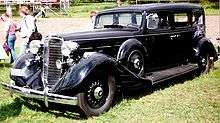 Nash Ambassador Eight 4-Door Sedan 1934
Nash Ambassador Eight 4-Door Sedan 1934 Nash Advanced Six Series 3520 4-Door Sedan 1935
Nash Advanced Six Series 3520 4-Door Sedan 1935 Nash 3540 400 4-Door Sedan 1935
Nash 3540 400 4-Door Sedan 1935 Nash 3540 400 4-Door Sedan 1935
Nash 3540 400 4-Door Sedan 1935 Nash Lafayette Series 3610 4-Door Sedan 1936
Nash Lafayette Series 3610 4-Door Sedan 1936 Nash Ambassador Six 3620 4-Door Sedan 1936
Nash Ambassador Six 3620 4-Door Sedan 1936 Nash 4-Door Sedan
Nash 4-Door Sedan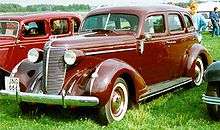 Nash Ambassador Six Series 3728 4-Door Sedan 1937
Nash Ambassador Six Series 3728 4-Door Sedan 1937 Nash Lafayette Series 3818 4-Door Sedan 1938
Nash Lafayette Series 3818 4-Door Sedan 1938 Nash Ambassador Six Series 3828 4-Door Sedan 1938
Nash Ambassador Six Series 3828 4-Door Sedan 1938 Nash 2-Door Sedan 1940
Nash 2-Door Sedan 1940 Nash 4-Door Sedan 1946
Nash 4-Door Sedan 1946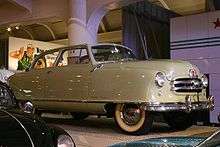 1950 Nash Rambler Convertible Coupe
1950 Nash Rambler Convertible Coupe.jpg) Australian right-hand drive 1957 Nash Rambler wagon
Australian right-hand drive 1957 Nash Rambler wagon.jpg) New Zealand right-hand drive 1959 Nash Metropolitan
New Zealand right-hand drive 1959 Nash Metropolitan Detail from a Nash Metropolitan
Detail from a Nash Metropolitan Nash dealership in Alabama, ca. 1930-1945
Nash dealership in Alabama, ca. 1930-1945
Nash automobiles
- Nash 600
- Nash Statesman
- Ambassador
- Metropolitan
- Nash-Healey - cooperation with Donald Healy, assembled in the UK and Italy
- Nash Rambler
- Rambler
Motorsport
Like most American manufacturers of the fifties, Nash was a participant in the Grand National Stock Car series.
See also
- Pratt & Whitney R-2800 Double Wasp, Nash built many of these during WWII.
References
- Inline
- Foster, Patrick R. AMC Cars 1954–1957, an Illustrated History, p.158. Iconografix 2004. ISBN 1-58388-112-3.
- Lewis, Albert L.; Musciano, Walter A. (1977). Automobiles of the World. Simon and Schuster. p. 280. ISBN 978-0-671-22485-1.
- Forbes, B.C.; Foster, O. D. (c. 2003) [1926]. Automotive Giants of America: Men Who Are Making Our Motor Industry. Forbes Publishing (Kessinger Publishing). pp. 211–224. ISBN 978-0-7661-6177-1.
- American industries, Volume 14. National Association of Manufacturers (U.S.). 1903. p. 124. Retrieved 29 August 2010.
- "Jeffrey Quad". 4wdonline.com. Retrieved 3 September 2010.
- Eckermann, Erik (2001). World history of the automobile. Society of Automotive Engineers. p. 76. ISBN 978-0-7680-0800-5. Retrieved 3 September 2010.
- "New York Curb and Industrial Issues". Copper curb and mining outlook: Volume 14. 14 (18): 15. 24 January 1917. Retrieved 3 September 2010.
- Botti, Timothy J. (2006). Envy of the world: a history of the U.S. economy & big business. Algora Publishing. p. 188. ISBN 978-0-87586-432-7. Retrieved 3 September 2010.
- Keller, Michael E. (1998). The Graham Legacy: Graham-Paige to 1932. Turner Publishing. ISBN 978-1-56311-470-0. Retrieved 3 September 2010.
- Flink, James J. (1990). The automobile age. MIT Press. p. 102. ISBN 978-0-262-56055-9. Retrieved 3 September 2010.
- Fregulia, Carolyn (2008). Logging in the Central Sierra. Arcadia Publishing SC. p. 86. ISBN 978-0-7385-5816-5. Retrieved 3 September 2010.
- Norbye, Jan P. (1981). The 100 greatest American cars. TAB Books. ISBN 978-0-8306-9623-9.
- Norbye, Jan P. (1981). The complete handbook of automotive power trains. TAB Books. ISBN 978-0-8306-9623-9.
- Wolfe, Steven J. (2000). "HVAC Time Line". Refrigeration Service Engineers Society Twin Cities Chapter. Archived from the original on 21 November 2009. Retrieved 18 June 2010.
- Automobiles of the '50s. Publications International. 1993. p. 63. ISBN 978-0-7853-2008-1.
- Mueller, Mike (1997). Fifties American Cars. MBI Publishing Company. p. 67. ISBN 9780879389246.
- "1951 Rambler Custom Landau". Howstuffworks.com.
- "Lois Lane's 1950 Nash Rambler Custom". Articboy.com.
- "TV Cars". Hemmings Classic Car, June 1, 2005, Jim Donnelly.
- Al Binder and the Ward's staff, "Rearview Mirror", Ward's AutoWorld, 2001-02-01 Archived 2011-11-24 at the Wayback Machine, retrieved on 2009-08-26.
- Daly, Steven (2006). Automotive Air-Conditioning and Climate Control Systems. Elsevier Science & Technology Books. p. 2. ISBN 978-0-7506-6955-9.
- Nunney, Malcolm J. (2006). Light and Heavy Vehicle Technology. Elsevier Science & Technology Books. p. 147. ISBN 978-0-7506-8037-0.
- "AMX Palm Beach", undated article by the auto editors of Consumer Guide. Retrieved on July 17, 2008.
- "Autos: Merger No. 3". Time. 28 June 1954. Retrieved 17 March 2013.
- "Personnel: Changes of the Week". Time. 25 October 1954. Retrieved 15 September 2013.
- "Autos: New Entry". Time. 24 March 1954. Retrieved 15 September 2013.
- Donovan, Leo (January 1955). "Detroit Listening Post". Popular Mechanics. 103 (1): 110. Retrieved 3 August 2015.
- Donovan, Leo (August 1954). "Detroit Listening Post". Popular Mechanics. 102 (2): 82. Retrieved 3 August 2015.
- Lamm, Michael; Holls, Dave (1996). A century of automotive style: 100 years of American car design. Lamm-Morada. pp. 201–202. ISBN 9780932128072. Retrieved 3 August 2015.
- Flory, Jr., J. "Kelly" (2008). American Cars, 1946-1959 Every Model Every Year. McFarland. p. 815. ISBN 9780786432295. Retrieved 3 August 2015.
- https://www.motorsportmagazine.com/archive/article/november-1957/22/cars-earls-court
- https://trove.nla.gov.au/newspaper/article/223565940
- https://trove.nla.gov.au/newspaper/article/223633967
- https://trove.nla.gov.au/newspaper/article/20564989
- https://trove.nla.gov.au/newspaper/article/210493487
- https://trove.nla.gov.au/newspaper/article/153261178
- https://trove.nla.gov.au/newspaper/article/121697641
- W D Rose, Development options in the New Zealand motor car assembly industry, Research paper 16, NZIER, 1971
- Todd Niall, The Empty Halls of New Zealand's Car Assembly Industry. Sunday Star Times, 6 October 2018 accessed 28 February 2019
- http://motor-assemblies.blogspot.com/2012/01/motor-assemblies-limited.html
- https://classicsworld.co.uk/nostalgia/retro-ads-rambler-classic-american/
- https://www.motorsportmagazine.com/archive/article/november-1956/14/cars-earls-court
- https://www.gracesguide.co.uk/Rambler_Motors
- General
- Gunnell, John, ed. (1987). The Standard Catalog of American Cars 1946–1975. Krause Publications. ISBN 978-0-87341-096-0.
External links
| Wikimedia Commons has media related to Nash Motors. |